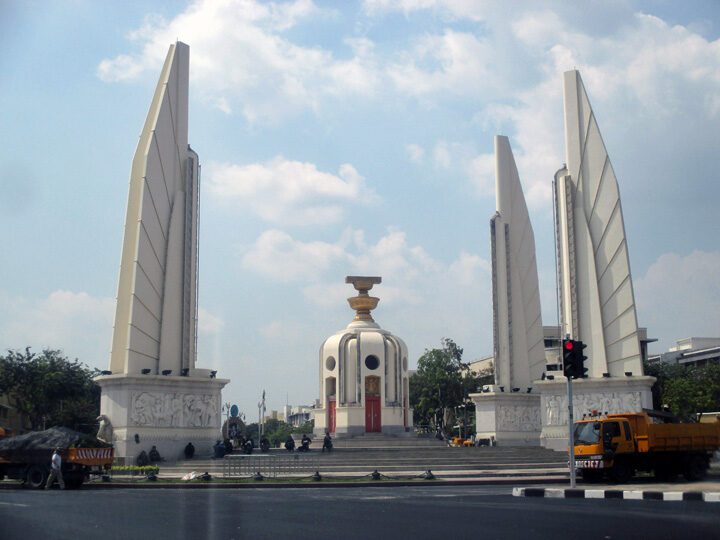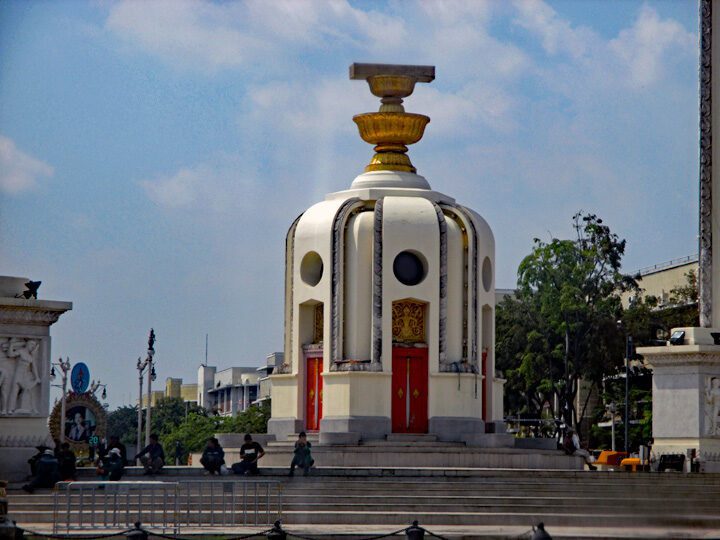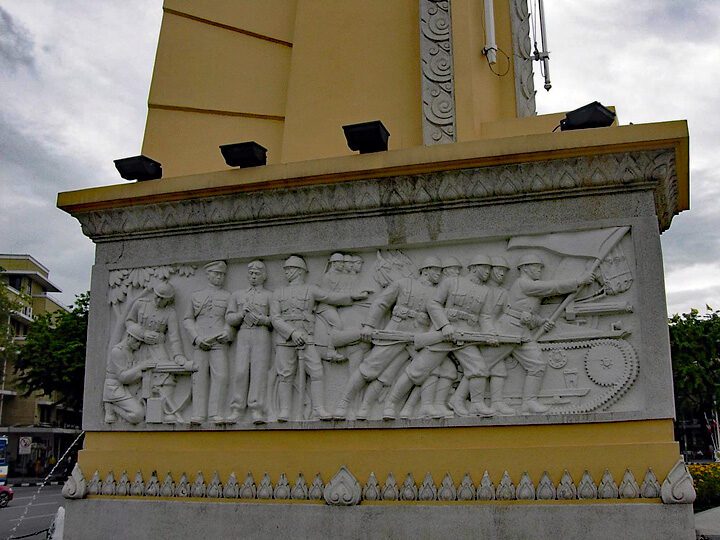The “Democracy Monument” in Bangkok
With the elections in prospect, it is nice to already have a democratic monument Bangkok to discover. A monument that owes its origin to the history of Thailand in 1932.
The monument was erected in 1939 in commemoration of the Siamese Revolution of 1932, which led to the formation of a constitutional monarchy which then became the Kingdom of Siam, governed by military rules led by Plaek Phibunsongkhram. Pibun saw this monument as the center of a "western" Bangkok, thinking of the Thanon Ratchadamnoen Road as the Champs-Elysées and the Democracy Memorial like an Arc de Triomphe of Bangkok. This monument is located between Sanam Luang, where the late king was cremated, and the Golden Mount (Phu Kao Thong).
An Italian sculptor Corrado Feroci became a citizen of Thailand under the name of Silpa Bhirasi in order to avoid Japanese imprisonment and possible execution in World War II. This artist is also the creator of the monument Lady Mo in Nakon Ratchasima in Korat (see posting Gringo February 18).
The construction of the "Democracy Memorial” was not well received by the residents in this area, especially many Chinese. People had to leave their homes and businesses for at least 60 days and hundreds of trees were cut down to create a wide boulevard. In a time without air conditioning, shady trees were critical.
The core of the monument is an ornately carved tower encompassing the 1932 Thai Constitution; on the top two gold bowls containing the box in which the constitution was to be kept. The constitution is symbolically guarded by four wing-like structures, representing the four branches of the Thai armed forces, the army, navy, air force and police, which carried out the 1932 coup.
The monument is full of symbols. The four wings are 24 meters high and refer to the coup d'état of June 24, 1932. The central tower is three meters high, which refers to the third month, June, according to the traditional Thai calendar. The six gates in the tower also refer to the six proclaimed policies of the Phibun regime, namely: “independence, internal peace, equality, freedom, economy and education. Two water spouting protective nagas (serpents) represent Hindu and Buddhist mythology.
Images in the form of sculptures have been placed at the foot of the monument, showing different messages. Soldiers fighting for democracy, working citizens, depicting a balance for a good life. However, while the king was on vacation, a small group of officers and civilians seized power. A first Thai constitution was far from democratic. Further democratization resulted in a split between military and civilians. Also, something of the royal house is missing from this monument, because the coup was intended against Rama Vll, who went into exile. His son Rama Vlll was still at school in Switzerland.
The origins of the Democracy Monument have been forgotten. It now serves as a rallying point for later generations of democracy activists. Mass student demonstrations against the military regime Thanom Kittikachornin in 1973 and the military coup in 1976. The Black May of 1992 and again in 2013-2014 a political crisis. This has given the monument an anchor point in Thai history.
With the Thai elections coming up in March 2019 under the current military rule of Prayuth-o Chan, it is interesting to follow this and what "democratic" rule will come in Thailand now. Time will tell!





Your description of the monument is fine, Lodewijk. I can add that more royalists in the sixties and seventies made an attempt to tear down the monument (albeit a bit anti-king). That didn't happen, but maybe it will.
Quote:
'His son Rama Vlll was still at school in Switzerland'.
Rama VIII was called Ananda Mahidol and became king at the age of nine in 1935 when his childless uncle (and not his father) abdicated. Ananda died under mysterious circumstances in June 1946 from a gunshot wound to his forehead, after which his younger brother, Bhumibol Adulyadej, succeeded him.
………childless uncle (and not his father) Rama VII abdicated.
Dear Louis,
Good article about an – in my opinion – extremely important monument in Bangkok. Only one small correction: King Prajathipol aka Rama VII was not the father but an uncle of Ananda Mahidol aka Rama VIII. His cousin was indeed still attending school in distant Switzerland when he abdicated on March 2, 1935. Rama VIII, except for a short visit in 1938, would not return to Thailand until 1946.
Democracy Monument (อนุสาวรีย์ประชาธิปไตย, Anoe–saa-wa-ri Pra-tja-thi-pa-tai) is built on Ratchadam road (ถนนราชด ำเนิน, tha-non raa-tja-dam-neun). The Royal Procession stands. The monument commemorates the revolution of 1932 when the royal house had to back down. It is therefore no coincidence that the monument is here, how you can interpret it and why there were and are forces that would rather see the monument disappear.
Gentlemen, thanks for the addition
And a small addition to a good article, Lodewijk.
Quote:
"The monument was erected in 1939 in commemoration of the Siamese Revolution of 1932, which led to the formation of a constitutional monarchy, which then became the Kingdom of Siam, governed by military rule under the leadership of Plaek Phibunsongkhram."
Well, the citizen Pridi Phanomyong, whom I admire very much, was also a leader of that Siamese revolution. That revolution was on June 24, 1932, so its commemoration is in three days! That is why the Monument to Democracy has already been fenced off with a sign saying that 'the monument is closed for renovation'. Yes, democracy is being 'renovated' and a celebration of it is better avoided. Revelers will be arrested for fears of corona spread.
This happens very often around a memorial day when a location is closed (renovation, disinfection, etc.) or there are simply some fences or plants around the monument, temple or object in question. For example, last month the temple where unarmed civilians were shot dead in 2010 was closed due to corona disinfection. It's pure coincidence, really.
The monument of democracy does make a nice roundabout (also under maintenance), as this picture shows:
https://m.facebook.com/maneehaschair/photos/a.263508430456154/494430317363963/?type=3&source=48
(Caption: Mani would like to know when this thing is over)
Oh, speaking of renovation: the man at the helm wants several buildings in this art-deco style to be demolished and given a new architectural look. See: https://www.khaosodenglish.com/news/2020/01/23/scholar-fears-massive-renovation-of-iconic-avenue-may-erase-history/
Well, every Thai knows those mysterious circumstances. But shhhh.